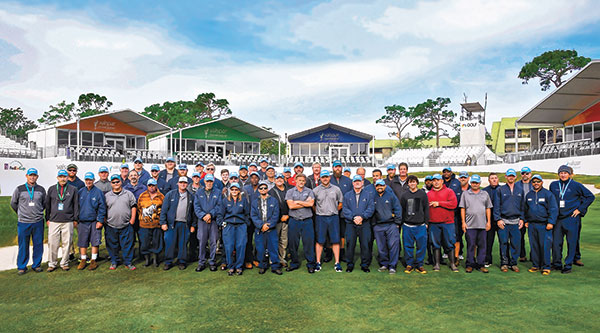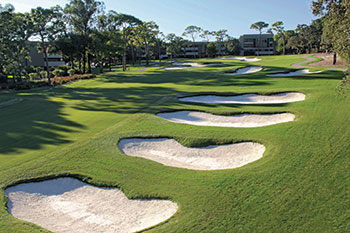Four courses, two superintendents, one vision

Copperhead’s par-3 13th hole, dubbed “Forced Carry,” plays at 199 yards during the PGA Tour’s Valspar Championship. (Photo courtesy of Innisbrook Resort)
As the home of the PGA Tour’s Valspar Championship, Palm Harbor, Fla.’s Innisbrook Resort is the center of the golf world’s attention one week every year. After all, major champions like Jordan Spieth, Vijay Singh, Jim Furyk and Retief Goosen are past winners.
There is, of course, much more to the resort than the Copperhead Course, which annually hosts the event. For starters, the resort provides guests with three restaurants, a spa, conference facilities, a variety of pools (including the Loch Ness, a large-scale pool with two waterslides), 11 tennis courts and 485 guest rooms and suites, each of which were renovated this year.
But above all, the resort offers golf, and plenty of it. Aside from the renowned Copperhead Course, it features three other courses, the Island, the North and the South. To properly oversee all four courses at once, superintendents Ryan Stewart (of the Copperhead and Island Courses) and Rob Koehler (of the North and South Courses) ensure they provide a consistent management style to their 65 staff members.
With regard to agronomic practices and daily routines in particular, they blend whatever works on each course into one seamless operation, an efficient and cost-effective method that has proven successful in the last few years. For example, they work together on each closing schedule (for maintenance) a year in advance and then plan their agronomic practices around these schedules.
“We set up aerification in such a manner that we all aerify our greens at 0.5 inch in May and June,” Koehler says. “The schedule is set so that we take the aerifiers from one course to the next weekly through the month. This way, we just stock one size of tine for all four courses monthly.

Ryan Stewart and Rob Koehler manage 65 employees between Innisbrook Resort’s four courses. Communication among them is key. (Photo courtesy of Innisbrook Resort)
“We also save on labor by not needing to reset the aerifiers after each use. We use this practice for each rotation of size, dependent on closing length and the time of year.”
Minimizing fertilization
At the same time, Stewart and Koehler also oversee similar fertilization and IPM programs. Because of this consistency, they have to stock only a minimum amount of pesticides at any given time. The North and South Courses alone have 26 tons of fertilizer (applied by six employees) for each application, using the same blend and application rate every time, so there’s lower potential for errors and misapplications. Ninety percent of the fertilizers are slow release, and every fertilizer is custom blended.
“We also try to rotate as many different fungicides as we can with different modes of action,” Koehler explains. “This technique guarantees there’s no disease resistance or tolerance buildup, so that whenever fungicides are needed, we can use the minimum application rates with the most effectiveness.”
Stewart and Koehler meet weekly to discuss their tasks for the upcoming week. In doing so, they avoid attempting to use the same equipment on different courses. And, of equal importance, they maintain constant communication with Innisbrook’s director of golf on events, course closures and the like, to ensure everyone on staff is working together efficiently. “I would say communication with everyone on the property has to be at its best in order for Innisbrook to be successful,” Stewart says. “As a result, members and guests will have the best experience possible.”
A well-mapped irrigation system

Pigment in liquid overseed gives fairways a boost in color and the appearance that they have been overseeded. (Photo courtesy of Innisbrook Resort)
There is no doubt about it. Innisbrook’s Copperhead Course is the focal point of the resort. Its name recognition is powerful, primarily because of its marketability as the annual host of the Valspar Championship. With this in mind, Stewart and his team decided to replace the Copperhead Course’s irrigation system before any of the other courses’ systems.
Replacement began in 2015, as Stewart first focused on the course’s pipes, replacing each one (originally built in 1970) with HDPE piping. His team worked quickly, because the course’s irrigation system was failing daily. Pipes were breaking, and irrigation heads were running all night long.
“The impact has been huge,” he states. “We now have a well-mapped irrigation system that has helped our operation run more efficiently.”
Furthermore, Stewart decided to transition from a hydraulic irrigation system to an electric system during the same year that the Copperhead Course’s pipes were replaced. The electric system, a Toro Lynx, communicates to various satellites throughout the course, which are connected to each sprinkler head — more than 1,200 in all.
“When we had our hydraulic system, the tubes in the control were so old that they weren’t working properly, leading to issues pretty much every day,” he adds. “In particular, the tubes broke in the ground and the heads ran nearly 24/7.
“The new system has given us the power to run as we need to,” he says, “so that there is considerably less wasted water on the course. With water supplies getting lower and becoming more critical, this upgraded irrigation system has been an enormous help to conserving a significant amount of water.”
From 2015 to 2016, the first year in which the new irrigation system was fully implemented, Stewart and his staff saved more than 11 million gallons of water. Such savings will be vitally important in the future, especially for Innisbrook’s maintenance department, as regulations concerning water savings continue to pile up.
Make water work better
At the same time, Koehler has been focused on water quality, attempting to determine the best way to make the resort’s water “work better” for him and his staff. To do so, he has been using a neutralizer product that is more readily available and safer to use than sulfuric acid.
“As a 15-0-0 with 16 percent sulfur and a pH of approximately 1, the neutralizer product is injected at a rate of 25 gallons per 100,000 gallons of irrigation, a calculation determined by a laboratory, into our irrigation system to neutralize salts, free up nutrients in the water and lower pH,” Koehler says. “In turn, it also aids in neutralizing and freeing nutrients bound in the soil, similar to sulfuric acid irrigation injection.”
The neutralizer has essentially changed the North and South Courses’ water from irrigation water to rainwater in the course’s pipes before it’s sprayed out of the sprinklers. Consequently, Koehler has been able to reduce nitrogen inputs by roughly 50 percent on both courses’ greens.
“I’m amazed at its performance, as I’ve seen better soil testing results than ever before,” he states. “I would certainly recommend it to anyone.”
Meanwhile, on the Island Course, Stewart and his staff use a TDR (a soil moisture meter) to determine how much irrigation they need to run at night. The TDR monitors greens to determine whether or not there are any localized dry spots, which can be watered before golfers ever notice them. This practice not only ensures guests have the best experience possible, but it also helps Stewart maintain a hard, fast course that also saves water long term.
The importance of liquid overseed
To further increase water savings, Stewart transitioned from overseeding on the Island Course to using a “liquid overseed” program.
“Now the 419 bermudagrass has no competition and has been able to thrive and provide excellent playing conditions throughout the year,” he says.
All of the Island Course’s fairways are sprayed with a liquid overseed (featuring some iron, a 25-0-0 nitrogen source and a pigment), which helps provide color, along with the appearance that the fairways have truly been overseeded. The method has proved so valuable that only par-3 tees have needed overseeding the last five years.
They use fertigation on the Island and Copperhead Courses, and it has helped maintain the courses’ fertility and grass health while supplementing the resort’s granular program throughout the year.
“We’re also able to put wetting agents through the fertigation tanks,” Stewart states. “This helps us in our dryer months, since we’re able to hold moisture in the plant rather than having hydrophobic areas all over the golf course.”
As Stewart and Koehler prepare for the future, they’re looking forward to installing new irrigation systems on the Island, North and South Courses as a means to further conserve water, improve soil and playing conditions and save potentially thousands of dollars long-term.
“We already have the designs and have priced out the jobs with various contractors,” Koehler explains. “We’re hoping to begin one of the courses in 2020, but the course hasn’t been determined yet.”
“We’re always looking for ways to improve our maintenance practices and enhance our golf courses,” Stewart adds. “I truly believe the best is yet to come for Innisbrook












